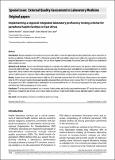Implementing a Regional Integrated Laboratory Proficiency Testing Scheme for Peripheral Health Facilities in East Africa
View/
Publication Date
2016-10-27Type
Otherviews
downloads
Metadata
Show full item recordCitation
Stephen Munene, Jackson Songok, Dennis Munene, Jane Carter Biochem Med (Zagreb) 2017 Feb 15; 27(1): 110–103. Published online 2017 Feb 15. doi: 10.11613/BM.2017.014
Abstract/
Introduction: Regular participation in external quality assessment (EQA) is critical for maintaining laboratory performance and is required for laboratory accreditation. Proficiency testing (PT) is effective for providing EQA, but available schemes rarely address the range of tests performed by peripheral laboratories in resource-limited settings. The East African Regional External Quality Assessment Scheme (EA-REQAS) was established in 2004 to address this need. Materials and methods: Surveys were distributed biannually comprising seven different panel materials and questions addressing laboratory, clinical and public health topics. Preserved materials were prepared using standard procedures and validated by accredited laboratories to establish target values. Survey materials were shipped by courier and results returned by paper copy, email or online. Immediate feedback reports included advice for addressing errors. Composite reports addressing participants’ performance were provided to national quality assurance offices. Results: Sixteen surveys were distributed between 2008 and 2015; enrolment increased from 195 to 560 facilities. Mean response rate remained static (56-59%), but overall number of participating facilities increased. Mean performance scores increased from 51% to 68% but remained below the accepted score of 80%; individual facilities achieving 80% or more increased from 0 to 25%. Facilities participating in 10 or more surveys performed better than facilities participating in 5 or less surveys. Conclusion: PT can be applied at peripheral level in resource-limited settings and identifies poorly performing areas. PT can also be used to assess performance of equipment and test kits as part of post-market surveillance. Smaller health facilities require additional support to address deficiencies.
Further Details
©Copyright by Croatian Society of Medical Biochemistry and Laboratory Medicine. This is an Open Access article distributed under the terms of the Creative Commons Attribution Non-Commercial License (http://creativecommons.org/licenses/by-nc-nd/4.0/) which permits unrestricted non-commercial use, distribution, and reproduction in any medium, provided the original work is properly cited.
Publisher
Biochemia MedicaCollections
- General - GEN [367]

